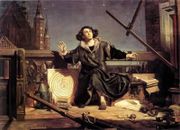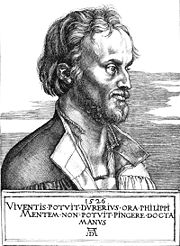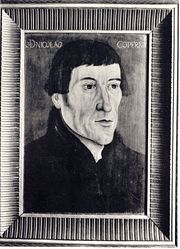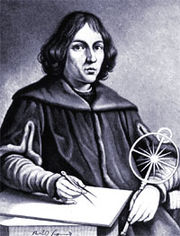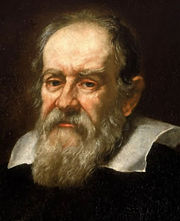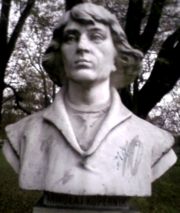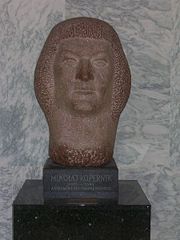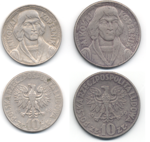Nicolaus Copernicus
From Wikipedia, the free encyclopedia
| The neutrality
of this article is disputed. Please see the discussion on the talk page. (March 2008) Please do not remove this message until the dispute is resolved. |
| Nicolaus Copernicus | |
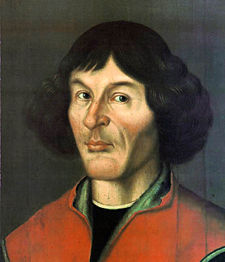 Portrait from Toruń,
early 16th
century | |
| Born | February 19, 1473(1473-02-19), Toruń (Thorn), Royal Prussia, Poland |
|---|---|
| Died | May 24, 1543
(aged 70), Frombork (Frauenburg), Warmia, Poland |
| Fields | Mathematician, astronomer, jurist, physician, classical scholar, Catholic cleric, governor, military commander, diplomat, economist |
| Alma mater | Jagiellonian University, Bologna University, University of Padua, University of Ferrara |
| Doctoral students | Georg Joachim Rheticus |
| Known for | Heliocentrism |
| Religious stance | Roman Catholic |
| Signature | |
Nicolaus Copernicus (February 19, 1473 – May 24, 1543) was the first astronomer to formulate a scientifically based heliocentric cosmology that displaced the Earth from the center of the universe. His epochal book, De revolutionibus orbium coelestium (On the Revolutions of the Celestial Spheres), is often regarded as the starting point of modern astronomy and the defining epiphany that began the Scientific Revolution.
Although Greek, Indian and Muslim savants had published heliocentric hypotheses centuries before Copernicus, his publication of a scientific theory of heliocentrism, demonstrating that the motions of celestial objects can be explained without putting the Earth at rest in the center of the universe, stimulated further scientific investigations and became a landmark in the history of modern science that is known as the Copernican Revolution.
Among the great polymaths of the Renaissance, Copernicus was a mathematician, astronomer, physician, classical scholar, translator, Catholic cleric, jurist, governor, military leader, diplomat and economist. Among his many responsibilities, astronomy figured as little more than an avocation — yet it was in that field that he made his mark upon the world.
Contents |
Life
Family
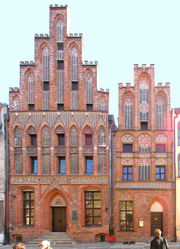
Nicolaus Copernicus was born on February 19, 1473, in a house on St. Anne's Street (now Copernicus Street) in the city of Toruń (Thorn). Toruń, situated on the Vistula River, was a city in Royal Prussia, an autonomous region of the Kingdom of Poland.[1] [2] Nicolaus was named after his father, who about 1458 had moved from Kraków. The father was a wealthy copper trader who had become a respected citizen of that city. Nicolaus' mother, Barbara Watzenrode (died after 1495), had been born into a wealthy merchant family that was part of the patrician class in Toruń.
Nicolaus's father died between 1483 and 1485. After that, his maternal uncle, Lucas Watzenrode the Younger (1447–1512), a church canon who would later become Prince-Bishop governor of the Archbishopric of Warmia, took young Nicolaus under his protection and saw to his education and future career. Nicolaus was the youngest of four children. His brother Andreas became an Augustinian canon at Frombork (Frauenburg). His sister Barbara (named after her mother) became a Benedictine nun. His sister Katharina married Barthel Gertner, a businessman and city councilor.
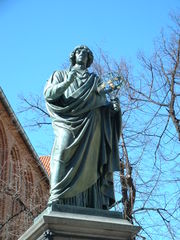
Name
Numerous variants of Copernicus's name are documented.[3] Until the mid-1530s, he mostly signed himself Coppernic. Afterward, he followed the academic custom of his time and adopted a Latinized version of his name. Thus, on the title page of his epochal book, Nicolai Copernici Torinensis De Revolutionibus Orbium Coelestium Libri VI, the astronomer's name appears as Nicolaus Copernicus.
In 1776, Johann Gottfried Herder introduced the spelling Nikolaus Kopernikus, which replaced each c with k and changed pp to p. This spelling became popular in German writings, although scholars argued for Coppernicus. The Polish rendering is Mikołaj Kopernik; the surname means "one who works with copper".[4]
Education
In 1491 Copernicus enrolled at the Kraków Academy (now Jagiellonian University), where he probably first encountered astronomy with Professor Albert Brudzewski. Astronomy soon fascinated him, and he began collecting a large library on the subject. Copernicus's library would later be carried off as war booty by the Swedes during "the Deluge" and is now at the Uppsala University Library.
After four years in Kraków, followed by a brief stay back home in Toruń, Copernicus went to study law and medicine at the universities of Bologna and Padua. Copernicus's uncle, Lucas Watzenrode the Younger, financed his education and hoped that Copernicus too would become a bishop. Copernicus, however, while studying canon and civil law at Bologna, met the famous astronomer, Domenico Maria Novara da Ferrara. Copernicus attended Novara's lectures and became his disciple and assistant. The first observations that Copernicus made in 1497, together with Novara, are recorded in Copernicus's epochal book, De revolutionibus orbium coelestium.
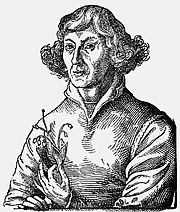
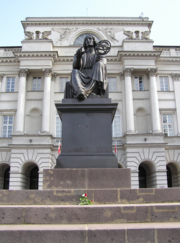
In 1497 Copernicus's uncle was ordained Bishop of Warmia, and Copernicus was named a canon at Frombork Cathedral. But Copernicus remained in Italy, where he attended the great Jubilee of 1500. He also went to Rome, where he observed a lunar eclipse and gave some lectures in astronomy and mathematics.
In 1501 Copernicus returned to Frombork. As soon as he arrived, he obtained permission to complete his studies in Padua, where he studied medicine (with Guarico and Fracastoro), and at Ferrara, where in 1503 he received his doctorate in canon law. One of the topics Copernicus must have studied at that time was astrology, since it was then considered to be an important part of a medical education.[5] However, unlike most other prominent renaissance astronomers, he appears to have never practiced it, or expressed any subsequent interest in it.[6] It has also been surmised that it was in Padua that he encountered passages from Cicero and Plato about opinions of the ancients on the movement of the Earth, and formed the first intuition of his own future theory. In 1504 Copernicus began collecting observations and ideas pertinent to his theory.
Work
In 1503 Copernicus returned to Polish Prussia, to the Prince-Bishopric of Warmia, where he resided the rest of his life. From 1503 until 1510 he had the position of secretary to his maternal uncle Lucas Watzenrode, Bishop of Warmia, and until 1510 resided in the Bishop's castle at Lidzbark (Heilsberg). It is there that he started work on his heliocentric view of the heavens[7]
In 1510 he moved to Frombork (Frauenburg), a town in the north and downstream of Toruń on the Vistula Lagoon. The Bishopric of Warmia, within Royal Prussia, though subject to the Polish crown, enjoyed substantial autonomy, with its own diet, army, monetary unit (the same as in the other parts of Prussia)[2] and treasury. Some time before his return to Warmia, he received a position at the Collegiate Church of the Holy Cross in Wrocław (Breslau), Silesia, Bohemia, which he held for many years and only resigned for health reasons shortly before his death. Copernicus remained for the rest of his life a burgher of Warmia (Bishopric of Warmia). During the Protestant Reformation he remained a loyal subject of the Catholic Prince-Bishops and the Catholic Polish King. Throughout his life he performed astronomical observations and calculations, but only as time permitted, and never in a professional capacity.
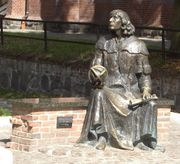
Between 1516-1521 Copernicus was economic administrator in Warmia. In this years He wrote manuscript - Locationes mansorum desertorum.
Copernicus oversaw the defense of the castle of Olsztyn (Allenstein) at the head of Royal Polish forces when the town was besieged by the Teutonic Knights during the Polish-Teutonic War (1519–1521). He also participated in the peace negotiations.[8]
Copernicus worked for years with the Royal Prussian diet, and with Duke Albert of Prussia, and advised Poland's King Sigismund I the Old on monetary reform. Holding the office of canon, he traveled extensively on government business and as a diplomat on behalf of the Prince-Bishop of Warmia.[9] He participated in the discussions in the East Prussian diet about coin reform in the Prussian countries. One issue of concern to participants of the Diet was who had the right to mint coins. The task required much diplomacy, but proved to be a success. Some of the difficulties came about because of the political upheavals occurring in Prussia at the time, such as the establishment of the Duchy of Prussia as a Protestant state in 1525. Copernicus translated the coin reform treatise into Latin for external use. In 1530 an agreement with Duke Albert was negotiated at Elbląg (Elbing).
In 1526 Copernicus wrote a study on the value of money, Monetae cudendae ratio. In it, Copernicus formulated an early iteration of the theory, now called "Gresham's Law," that "bad" (debased) coinage drives "good" (un-debased) coinage out of circulation, 70 years before Gresham. He also formulated a version of quantity theory of money.
Two years before Copernicus's death, Duke Albert urgently summoned him to Königsberg to treat one of his counsellors, who was dangerously ill. The patient recovered within a month or so, and Copernicus then returned to Frombork.[10]
In 1551, under Duke Albert's patronage, Erasmus Reinhold published the Prutenic Tables, a set of astronomical tables based on Copernicus's work, which astronomers and astrologers quickly adopted in place of those which they had superseded.[11]
Heliocentrism
In 1514 Copernicus made available to friends his Commentariolus (Little Commentary), a six page hand-written text describing his ideas about the heliocentric hypothesis. It contained seven basic assumptions. Thereafter he continued gathering data for a more detailed work.
In 1533, Johann Albrecht Widmannstetter delivered in Rome a series of lectures outlining Copernicus's theory. The lectures were heard with interest by Pope Clement VII and several Catholic cardinals.
On 1 November 1536, Archbishop of Capua Nicholas Schönberg wrote a letter to Copernicus from Rome:
Some years ago word reached me concerning your proficiency, of which everybody constantly spoke. At that time I began to have a very high regard for you... For I had learned that you had not merely mastered the discoveries of the ancient astronomers uncommonly well but had also formulated a new cosmology. In it you maintain that the earth moves; that the sun occupies the lowest, and thus the central, place in the universe... Therefore with the utmost earnestness I entreat you, most learned sir, unless I inconvenience you, to communicate this discovery of yours to scholars, and at the earliest possible moment to send me your writings on the sphere of the universe together with the tables and whatever else you have that is relevant to this subject ...[13]
By then Copernicus's work was nearing its definitive form, and rumors about his theory had reached educated people all over Europe. Despite urgings from many quarters, Copernicus delayed with the publication of his book, perhaps from fear of criticism — a fear delicately expressed in the subsequent Dedication of his masterpiece to Pope Paul III. Scholars disagree on whether Copernicus's concern was limited to physical and philosophical objections from other natural philosophers, or whether he was also concerned about religious objections from theologians.[14]
The book
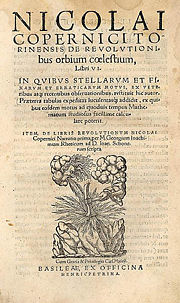
Copernicus was still working on De revolutionibus orbium coelestium (even if not convinced that he wanted to publish it) when in 1539 Georg Joachim Rheticus, a Wittenberg mathematician, arrived in Frombork. Philipp Melanchthon had arranged for Rheticus to visit several astronomers and study with them.
Rheticus became Copernicus's pupil, staying with him for two years and writing a book, Narratio prima (First Account), outlining the essence of Copernicus's theory. In 1542 Rheticus published a treatise on trigonometry by Copernicus (later included in the second book of De revolutionibus).
Under strong pressure from Rheticus, and having seen the favorable first general reception of his work, Copernicus finally agreed to give De revolutionibus to his close friend, Tiedemann Giese, bishop of Chełmno (Kulm), to be delivered to Rheticus for printing by Johannes Petreius at Nuremberg (Nürnberg).
Death
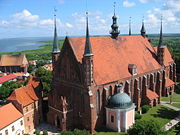
Copernicus died on May 24, 1543, in Frombork. Legend has it that the first printed copy of De revolutionibus was placed in Copernicus's hands on the very day he died, allowing him to take farewell of his opus vitae (life's work). He is reputed to have woken from a stroke-induced coma, looked at his book, and died peacefully.
Copernicus was reportedly buried in the Cathedral of Frauenburg where archeologists had long searched in vain for his remains. In August 2005, a team of archeologists led by Jerzy Gąssowski, head of an archaeology and anthropology institute in Pułtusk, discovered what they believe to be Copernicus's grave and remains, after scanning beneath the floor of the Cathedral. The find came after a year of searching, and the discovery was announced only after further research, on November 3. Gąssowski said he was "almost 100 percent sure it is Copernicus". Forensic expert Capt. Dariusz Zajdel of the Central Forensic Laboratory of the Polish Police used the skull to reconstruct a face that closely resembled the features — including a broken nose and a scar above the left eye — on a Copernicus self-portrait.[15] The expert also determined that the skull had belonged to a man who had died about age 70 — Copernicus's age at the time of his death. The grave was in poor condition, and not all the remains were found. The archeologists hoped to find deceased relatives of Copernicus in order to attempt DNA identification.
Copernican system
Predecessors
Early traces of a heliocentric model are found in several anonymous Vedic Sanskrit texts composed in ancient India before the 7th century BCE. Additionally, in the sixth century the Indian astronomer and mathematician Aryabhata anticipated elements of Copernicus's work, although he did not maintain heliocentrism.
Aristarchus of Samos in the 3rd century BCE elaborated some theories of Heraclides Ponticus (the daily rotation of the Earth on its axis, the revolution of Venus and Mercury around the Sun) to propose what was the first scientific model of a heliocentric solar system: the Earth and all other planets revolving around the Sun, the Earth rotating around its axis daily, the Moon in turn revolving around the Earth once a month. His heliocentric work has not survived, so we can only speculate about what led him to his conclusions. It is notable that, according to Plutarch, a contemporary of Aristarchus accused him of impiety for "putting the Earth in motion".
Copernicus cited Aristarchus and Philolaus in a surviving early manuscript of his book, stating: "Philolaus believed in the mobility of the earth, and some even say that Aristarchus of Samos was of that opinion." For reasons unknown (possibly from reluctance to quote pre-Christian sources), he did not include this passage in the published book. It has been argued that in developing the mathematics of heliocentrism Copernicus drew on not just the Greek, but also the work of Muslim astronomers, especially the works of Nasir al-Din Tusi (Tusi-couple), Mo'ayyeduddin Urdi (Urdi lemma) and Ibn al-Shatir. In his major work, Copernicus also discussed the theories of Ibn Battuta and Averroes.
Ptolemy
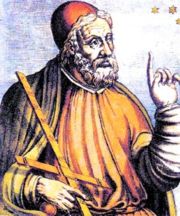
The prevailing theory in Europe as Copernicus was writing was that created by Ptolemy in his Almagest, dating from about A.D. 150. The Ptolemaic system drew on many previous theories that viewed Earth as a stationary center of the universe. Stars were embedded in a large outer sphere which rotated relatively rapidly, while the planets dwelt in smaller spheres between — a separate one for each planet.
Copernicus
Copernicus's major theory was published in the book, De revolutionibus orbium coelestium (On the Revolutions of the Celestial Spheres), in the year of his death, 1543, though he had arrived at his theory several decades earlier.
In his Commentariolus Copernicus had summarized his system with the following list of seven assumptions:[16]
- There is no one center of all the celestial circles or spheres.
- The center of the earth is not the center of the universe, but only of gravity and of the lunar sphere.
- All the spheres revolve about the sun as their mid-point, and therefore the sun is the center of the universe.
- The ratio of the earth's distance from the sun to the height of the firmament is so much smaller than the ratio of the earth's radius to its distance from the sun that the distance from the earth to the sun is imperceptible in comparison with the height of the firmament.
- Whatever motion appears in the firmament arises not from any motion of the firmament, but from the earth's motion. The earth together with its circumjacent elements performs a complete rotation on its fixed poles in a daily motion, while the firmament and highest heaven abide unchanged.
- What appear to us as motions of the sun arise not from its motion but from the motion of the earth and our sphere, with which we revolve about the sun like any other planet. The earth has, then, more than one motion.
- The apparent retrograde and direct motion of the planets arises not from their motion but from the earth's. The motion of the earth alone, therefore, suffices to explain so many apparent inequalities in the heavens.
De revolutionibus itself was divided into six books:
- General vision of the heliocentric theory, and a summarized exposition of his idea of the World
- Mainly theoretical, presents the principles of spherical astronomy and a list of stars (as a basis for the arguments developed in the subsequent books)
- Mainly dedicated to the apparent motions of the Sun and to related phenomena
- Description of the Moon and its orbital motions
- Concrete exposition of the new system
- Concrete exposition of the new system
Copernicanism
At original publication, Copernicus's epoch-making book caused only mild controversy, and provoked no fierce sermons about contradicting Holy Scripture. It was only three years later, in 1546, that a Dominican, Giovanni Maria Tolosani, denounced the theory in an appendix to a work defending the absolute truth of Scripture.[17] He also noted that the Master of the Sacred Palace (i.e., the Catholic Church's chief censor), Bartolomeo Spina, a friend and fellow Dominican, had planned to condemn De revolutionibus but had been prevented from doing so by his illness and death.[18]
Arthur Koestler, in his popular book The Sleepwalkers, asserted that Copernicus's book had not been widely read on its first publication.[19] This claim was trenchantly criticised by Edward Rosen,[20] and has been decisively disproved by Owen Gingerich, who examined every surviving copy of the first two editions and found copious marginal notes by their owners throughout many of them. Gingerich published his conclusions in 2004 in the ironically-titled The Book Nobody Read.[21]
It has been much debated why it was not until six decades after Spina and Tolosani's attacks on Copernicus's work that the Catholic Church took any official action against it. Proposed reasons have included the personality of Galileo Galilei and the availability of evidence such as telescope observations.
In March 1616, in connection with the Galileo affair, the Roman Catholic Church's Congregation of the Index issued a decree suspending De revolutionibus until it could be "corrected," on the grounds that the supposedly Pythagorean doctrine[22] that the Earth moves and the Sun doesn't was "false and altogether opposed to Holy Scripture."[23] The same decree also prohibited any work that defended the mobility of the Earth or the immobility of the Sun, or that attempted to reconcile these assertions with Scripture.
On the orders of Pope Paul V, Cardinal Robert Bellarmine gave Galileo prior notice that the decree was about to be issued, and warned him that he could not "hold or defend" the Copernican doctrine.[24] The corrections to De revolutionibus, which omitted or altered nine sentences, were issued four years later, in 1620.[25]
In 1633 Galileo Galilei was convicted of grave suspicion of heresy for "following the position of Copernicus, which is contrary to the true sense and authority of Holy Scripture,"[26] and was placed under house arrest for the rest of his life.
Galileo had gotten off lightly. Another Copernican, Giordano Bruno, had been prosecuted in Rome by the same Cardinal Bellarmine and on February 17, 1600, burned at the stake as a heretic primarily for his theologic views and not necessarily his scientific ones.
The Catholic Church's 1758 Index of Prohibited Books omitted the general prohibition of works defending heliocentrism,[27] but retained the specific prohibitions of the original uncensored versions of De revolutionibus and Galileo's Dialogue Concerning the Two Chief World Systems. Those prohibitions were finally dropped from the 1835 Index.[28]
It has been asserted[29] that medieval scholars had known that the Earth was a sphere and that, paradoxically, it might have been Copernicus's criticism of the early Christian author Lactantius (ca. 240 – ca. 320 C.E.) in De revolutionibus that later developed into the flat-Earth myth.
Nationality and ethnicity
Both the nationality and ethnicity of Copernicus are disputed. His father has been described by some as a Pole, and his mother was most likely of German origin.[30] The family came originally from the Silesian village of the same name (Coprnik, Copernik, Copirnik, Copernic, Kopernic, today Koperniki) near Nysa. In the 14th century, members of the family had begun moving to Silesian and later to Polish cities: Kraków (1367) and Toruń (1400), and also to Lviv (1439—then the Polish city, Lwów). The astronomer's father (probably the son of Jan) came from the Kraków line. He appears in records for the first time in 1448 as a well-to-do merchant who dealt in copper with Gdańsk. In the early period of the Pomeranian cities' struggle for independence from the Teutonic Order, in August 1454, he mediated financial negotiations between Cardinal Zbigniew Oleśnicki and the great Prussian cities regarding repayment of a loan for the Polish-Teutonic war. About 1458 the future astronomer's father moved from Poland's capital, Kraków, to Toruń, where a few years later (before 1464) he married Barbara, daughter of a wealthy Toruń patrician and city councillor, Lucas Watzenrode the elder (died 1462).[31]
The Watzenrodes had likewise come from Silesia, from the Świdnica (Schwednitz) region, and had settled in Toruń after 1360. The astronomer's grandfather Watzenrode was a decided opponent of the Teutonic Order. In 1453 he was the delegate from Toruń at the Grudziądz conference that planned the anti-Teutonic-Order uprising, and during the Thirteen Years' War he actively supported the struggle of the Prussian cities not only with substantial monetary subsidies but with political activity in Toruń and Gdańsk as well as with his own personal participation in battles at Łaszyn and Malbork. He died in 1462, leaving three children: Lucas (1447–1512), future Bishop of Warmia and the astronomer's patron, and two daughters: Barbara, the astronomer's mother (died after 1495), and Christina (died before 1502), who in 1459 married the merchant and Toruń mayor, Tiedeman von Allen. Through the Watzenrodes' extensive family relationships by marriage, the future astronomer was related both to wealthy burgher families of Kraków, Toruń, Gdańsk and Elbląg and to prominent noble families of Prussia: the Działyński, Kościelicki and Konopacki families.[32]
It remains a matter of dispute whether a "nationality" should be ascribed to Nicolaus Copernicus retrospectively and, if so, whether he should be considered German or Polish.[33] Already in the 123-year period when no Polish state existed (see History of Poland, 1795–1918), the matter was debated in German writings; nevertheless, the 1875 Allgemeine Deutsche Biographie acknowledged the Polish aspects of Copernicus's life.[34] Current German sources call the controversy, as reflected in the older literature, superfluous and shameful.[35]
Encyclopædia Britannica,[36] Encyclopedia Americana,[37] and the Microsoft Encarta Online Encyclopedia[38] identify Copernicus as Polish.
Copernicus was born, grew up, and spent most of his life in Royal Prussia and therefore was a subject of the Crown of the Polish Kingdom.[39] It is possible, therefore, that Copernicus's early years were spent in a "German" environment, while his later years were passed in a more "Polish" milieu, or to quote the Stanford Encyclopedia of Philosophy, "Thus the child of a German family was a subject of the Polish crown."[40] However, in his time "nationality" had yet to play as important a role as it would later, and people generally did not think of themselves primarily as Polish or German.[41].
Nevertheless, some have preferred to assign a single nationality to Copernicus. Nazi Germany claimed Copernicus to have been purely German,[42] while Poland has always promoted him as purely Polish.
Even today, some Germans and Poles continue to regard him as having been exclusively one of their own. Poland has issued coins and a banknote bearing Copernicus's portrait.
See also
- Copernican principle
- Dedication to Pope Paul III
- List of things named after Copernicus
- Inferior and superior planets
- History of philosophy in Poland
- Copernicus Airport Wrocław
- Scientific revolution
Notes
- ^ Barbara Bieńkowska, The Scientific World of Copernicus: On the Occasion of the 500th Anniversary of His Birth, 1473–1973, 1973, p. 137: "His country was the province of ancient Royal Prussia, composed of his native Toruń and Warmia, both components of the Polish state since 1454."
- ^ a b Jean W. Sedlar, East Central Europe in the Middle Ages 1000-1500, 1994, p. 281-282 [1]: "The Prussians themselves viewed their territory as united to Poland only through the king's person. [...] Social and ethnic differences reinforced this separateness."
- ^ Hans Koeppen et. al., Nicolaus Copernicus zum 500. Geburtstag, Cologne, 1973, ISBN 3-412-83573-2
- ^ "O historii i o współczesności". In Polish. Retrieved on 2007-04-22.
- ^ Rabin (2005).
- ^ Gingerich (2004, pp.187–189,201 ); Koyré (1973, p.94); Kuhn (1957, p.93); Rosen (2004, p.123); Rabin (2005).
- ^ Copernicus' Secret by Jack Repcheck, ISBN 978-0-7432-8951-1 - p.51
- ^ Copernicus' Secret by Jack Repcheck, ISBN 978-0-7432-8951-1 - p.66
- ^ Prof. Fred L. Wilson of the Rochester Institute of Technology. "Copernicus".
- ^ Koyré (1973, p.80), Armitage (1951, pp.52–53)
- ^ Kuhn (1957, pp.187–88)
- ^ Open Stock Photography, Jan Matejko. "The astronomer Copernicus: Conversation with God."[2]
- ^ Full text - Nicholas Copernicus, "De Revolutionibus (On the Revolutions)," 1543 C.E
- ^ Koyré (1973, pp.27, 90) and Rosen (1995, pp.64,184) take the view that Copernicus was indeed concerned about possible objections from theologians, while Lindberg and Numbers (1986) argue against it. Koestler (1963) also denies it. Indirect evidence that Copernicus was concerned about objections from theologians comes from a letter written to him by Andreas Osiander in 1541, in which Osiander advises Copernicus to adopt a proposal by which he says "you will be able to appease the Peripatetics and theologians whose opposition you fear." (Koyré, 1973, pp.35, 90)
- ^ "Czy tak wyglądał Mikołaj Kopernik?". In Polish. Retrieved on 2007-04-22.
- ^ Translated by Rosen (2004, p. 58–59).
- ^ Rosen (1995, pp.151–59)
- ^ Rosen (1995, p.158)
- ^ Koestler (1959, p.191)
- ^ Rosen (1995, pp.187–192), originally published in 1967 in Saggi su Galileo Galilei . Rosen is particularly scathing about this and other statements in The Sleepwalkers which he criticises as inaccurate.
- ^ Gingerich (2004), DeMarco (2004) [3]
- ^ In fact, in the Pythagorean cosmological system the Sun was not motionless.
- ^ Decree of the General Congregation of the Index, March 5, 1616 (translated from the Latin by Finocchiaro,1989, as cited by Gagné, 2005 [4]).
- ^ Fantoli (2005, pp.118–19); Finocchiaro (1989), as cited by Gagné (2005). Inquisition Minutes of 25 February, 1616 [5]; Cardinal Bellarmine's certificate of 26 May, 1616 [6]. This would not have prevented Galileo from discussing heliocentrism solely as a mathematical hypothesis, but a stronger formal injunction not to teach it "in any way whatever, either orally or in writing", allegedly issued to him by the Commissary of the Holy Office, Father Michelangelo Segizzi, would certainly have done so (Fantoli, 2005, pp.119–20, 137). There has been much controversy over whether the copy of this injunction in the Vatican archives is authentic; if so, whether it was ever issued; and if so, whether it was legally valid (Fantoli, 2005, pp.120–43).
- ^ Catholic Encyclopedia.
- ^ Papal Condemnation (Sentence) of Galileo, June 22, 1633 (translated from the Latin), in Giorgio de Santillana, The Crime of Galileo, University of Chicago Press, 1955, pp. 306-10.
- ^ Heilbron (2005, p. 307); Coyne (2005, p. 347).
- ^ McMullin (2005, p. 6); Coyne (2005, p. 346-47).
- ^ By Jeffrey Burton Russell (1997, p.64), for instance
- ^ Rudnicki, Konrad (November-December 2006). "The Genuine Copernican Cosmological Principle". Southern Cross Review: note 2.
- ^ Jerzy Dobrzycki and Leszek Hajdukiewicz, "Kopernik, Mikołaj", Polski słownik biograficzny, vol. XIV, 1969, pp. 3-4.
- ^ Dobrzycki and Hajdukiewicz, Polski słownik biograficzny, vol. XIV, p. 4.
- ^ Stuart Parkes, Understanding Contemporary Germany. ISBN 0-415-14123-0
- ^ Allgemeine Deutsche Biographie, Gesamtübersicht, Bd. 4, Seite 461. [7]
- ^ Der Streit in der Literatur darüber, ob Kopernikus ein Deutscher oder ein Pole sei, war überflüssig und beschämend. Leider ist die ältere Literatur davon durchsetzt.University of Braunschweig
- ^ "Copernicus, Nicolaus". Encyclopædia Britannica Online. (2007). Encyclopædia Britannica. Retrieved on 2007-09-21. ,
- ^ "Copernicus, Nicolaus", Encyclopedia Americana, vol. 7, pp. 755–56, 1986.
- ^ "Nicolaus Copernicus, Polish astronomer". Microsoft Encarta Online Encyclopedia. (2007). Microsoft. Retrieved on 2007-09-21.
- ^ "Nicolaus Copernicus". Stanford Encyclopedia of Philosophy. Retrieved on 2007-04-22.
- ^ Nicolaus Copernicus (Stanford Encyclopedia of Philosophy)
- ^ Norman Davies, God's Playground: A History of Poland, [8]. ISBN 0-231-05353-3.
- ^ Diemut Majer, Non-Germans Under the Third Reich: The Nazi Judicial and Administrative System in Germany and occupied Eastern Europe with special regard to occupied Poland, 1939-1945, [9]. ISBN 0-8018-6493-3
References
- Armitage, Angus (1951). The World of Copernicus. New York, NY: Mentor Books. ISBN 0-8464-0979-8.
- Coyne, George V., S.J. (2005). The Church's Most Recent Attempt to Dispel the Galileo Myth, In McMullin (2005, pp.340–59).
- DeMarco, Peter (2004-04-13). "Book quest took him around the globe". Boston Globe. Retrieved on 2008-01-14.
- Dobrzycki, Jerzy, and Leszek Hajdukiewicz, "Kopernik, Mikołaj," Polski słownik biograficzny (Polish Biographical Dictionary), vol. XIV, Wrocław, Polish Academy of Sciences, 1969, pp. 3–16.
- Fantoli, Annibale (2005). The Disputed Injunction and its Role in Galileo's Trial, In McMullin (2005, pp.117–49).
- Finocchiaro, Maurice A. (1989). The Galileo Affair: A Documentary History. Berkeley, CA: University of California Press. ISBN 0-520-06662-6.
- Gagné, Marc (2005). "Texts from The Galileo Affair: A Documentary History edited and translated by Maurice A. Finocchiaro". West Chester University course ESS 362/562 in History of Astronomy. Retrieved on 2008-01-15. (Extracts from Finocchiaro (1989))
- Gingerich, Owen (2004). The Book Nobody Read. London: William Heinemann. ISBN 0-434-01315-3.
- David C. Goodman and Colin A. Russell, eds. (1991). The Rise of Scientific Europe, 1500-1800. Dunton Green, Sevenoaks, Kent: Hodder & Stoughton: The Open University. ISBN 0-340-55861-X.
- Heilbron, John L. (2005). Censorship of Astronomy in Italy after Galileo, In McMullin (2005, pp.279–322).
- Koestler, Arthur [1959] (1963). The Sleepwalkers: A History of Man's Changing Vision of the Universe. New York, NY: Grosset & Dunlap. ISBN 0448001594. Original edition published by Hutchinson (1959, London).
- Koyré, Alexandre (1973). The Astronomical Revolution: Copernicus – Kepler – Borelli. Ithaca, NY: Cornell University Press. ISBN 0-8014-0504-1.
- Kuhn, Thomas (1957). The Copernican Revolution: Planetary Astronomy in the Development of Western Thought. Cambridge, MA: Harvard University Press. ISBN 0-674-17100-4.
- Lindberg, David C. and Numbers, Ronald L.. "Beyond War and Peace: A Reappraisal of the Encounter between Christianity and Science". American Scientific Affiliation article. Retrieved on 2007-04-22. - Paper originally published in Church History (Vol. 55, No. 3, Sept. 1986).
- McMullin, Ernan, ed. (2005). The Church and Galileo. Notre Dame, IN: University of Notre Dame Press. ISBN 0-268-03483-4.
- Rabin, Sheila (2005). "Copernicus". The Stanford Encyclopedia of Philosophy (Summer 2005 Edition), Edward N. Zalta (ed.). Retrieved on 2008-05-26.
- Rosen, Edward (1995). Copernicus and his Successors. London: Hambledon Press. ISBN 1 85285 071 X.
- Rosen, Edward (translator) [1939] (2004). Three Copernican Treatises:The Commentariolus of Copernicus; The Letter against Werner; The Narratio Prima of Rheticus, Second Edition, revised, New York, NY: Dover Publications. ISBN 0486436055.
- Russell, Jeffrey Burton [1991] (1997). Inventing the Flat Earth—Columbus and Modern Historians. New York, NY: Praeger. ISBN 0-275-95904-X.
Further reading
- Danielson, Dennis Richard (2006). The First Copernican: Georg Joachim Rheticus and the Rise of the Copernican Revolution. New York: Walker & Company. ISBN 0-8027-1530-3.
- Prowe, Leopold (1884). Nicolaus Coppernicus (in German). Berlin: Weidmannsche Verlagsbuchhandlung.
- Repcheck, Jack (2007). Copernicus' Secret: How the Scientific Revolution Began. New York: Simon & Schuster. ISBN 0-7432-8951-X.
- Nicolaus Copernicus Gesamtausgabe (Nicolaus Copernicus Complete Edition) (1974-2004), 9 vols., various editors (in German and Latin). Berlin: Akademie Verlag. A large collection of writings by and about Copernicus.
- Nicolaus Copernicus Gesamtausgabe: Biographies and Portraits of Copernicus from 16th to 18th century, Biographia Copernicana, 2004, ISBN 3-05-003848-9 [10] [11]
- Schmauch, Hans: Copernicus, Nicolaus. In: Neue Deutsche Biographie (NDB). Bd. 3, Berlin 1957, S. 348–355. (German)
- Bruhns, Christian: Copernicus, Nicolaus. In: Allgemeine Deutsche Biographie (ADB). Bd. 4, Leipzig 1876, S. 461–469. (German)
External links
- Primary Sources
- Works by Nicolaus Copernicus at Project Gutenberg
- De Revolutionibus, autograph manuscript — Full digital facsimile, Jagiellonian University
- (Polish) Copernicus's letters to various celebrities, among others the King Sigmundus I of Poland
- General
- O'Connor, John J. & Robertson, Edmund F., "Nicolaus Copernicus", MacTutor History of Mathematics archive
- Copernicus in Torun
- Nicolaus Copernicus Museum in Frombork
- Portraits of Copernicus: Copernicus's face reconstructed; Portrait; Nicolaus Copernicus
- Copernicus and Astrology — Cambridge University: Copernicus had – of course – teachers with astrological activities and his tables were later used by astrologers.
- Stanford Encyclopedia of Philosophy entry
- Find-A-Grave profile for Nicolaus Copernicus
- 'Body of Copernicus' identified — BBC article including image of Copernicus using facial reconstruction based on located skull
- Copernicus and Astrology
- Nicolaus Copernicus on the 1000 Polish Zloty banknote.
- Parallax and the Earth's orbit [12]
- Copernicus's model for Mars [13]
- Retrograde Motion[14]
- Copernicus's explanation for retrograde motion [15]
- Geometry of Maximum Elongation [16]
- Copernican Model [17]
- About De Revolutionibus
- The Copernican Universe from the De Revolutionibus
- De Revolutionibus, 1543 first edition — Full digital facsimile, Lehigh University
- The front page of the De Revolutionibus
- The text of the De Revolutionibus
- A java applet about Retrograde Motion
- The Antikythera Calculator (Italian and English versions)
- Pastore Giovanni, ANTIKYTHERA E I REGOLI CALCOLATORI, Rome, 2006, privately published
- Legacy
- (Italian) Copernicus in Bologna — in Italian
- Chasing Copernicus: The Book Nobody Read — Was One of the Greatest Scientific Works Really Ignored? All Things Considered. NPR
- Copernicus and his Revolutions — A detailed critique of the rhetoric of De Revolutionibus
- Article which discusses Copernicus's debt to the Arabic tradition
- German-Polish cooperation
- (German)(Polish) German-Polish school project on Copernicus
- (German)(English)(Polish) Büro Kopernikus - An initiative of German Federal Cultural Foundation
- (German)(Polish) German-Polish "Copernicus Prize" awarded to German and Polish scientists (DFG website) (FNP website)
| Persondata | |
|---|---|
| NAME | Copernicus, Nicolaus |
| ALTERNATIVE NAMES | |
| SHORT DESCRIPTION | astronomer |
| DATE OF BIRTH | 19 February 1473, |
| PLACE OF BIRTH | Toruń (Thorn), Royal Prussia, Poland. |
| DATE OF DEATH | 24 May 1543, |
| PLACE OF DEATH | Frombork (Frauenburg), Warmia (Ermeland). |

